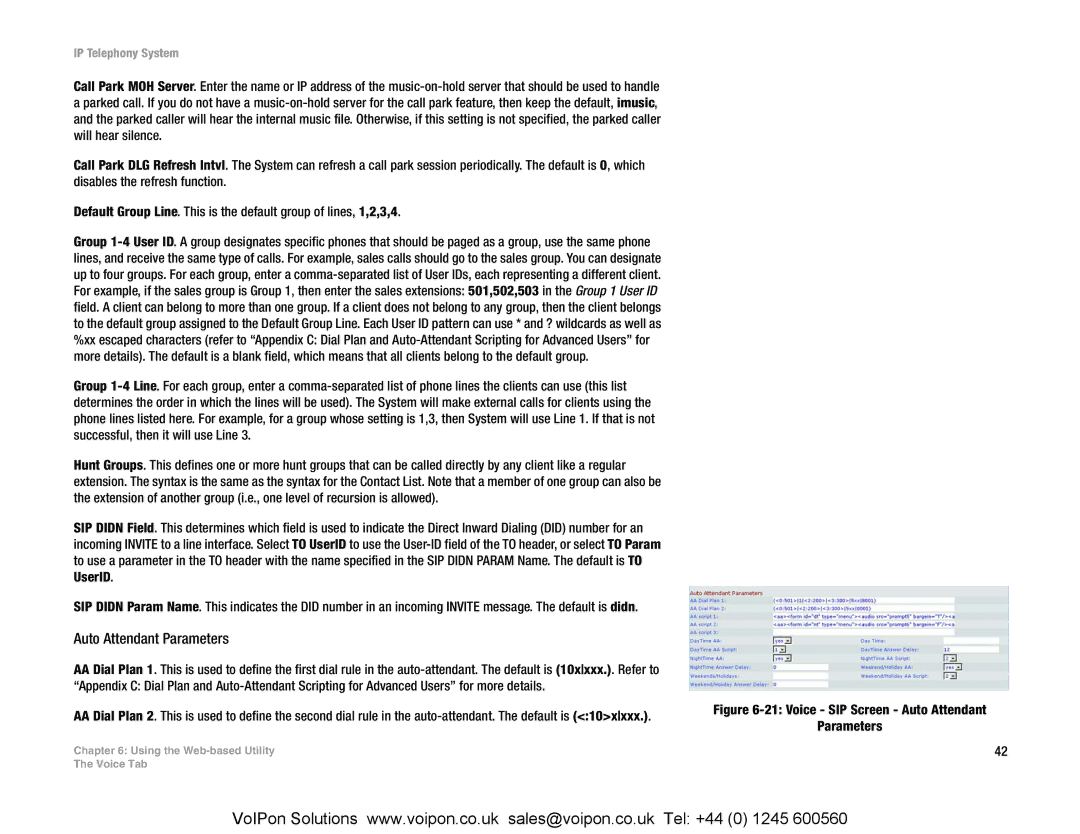IP Telephony System
Call Park MOH Server. Enter the name or IP address of the music-on-hold server that should be used to handle a parked call. If you do not have a music-on-hold server for the call park feature, then keep the default, imusic, and the parked caller will hear the internal music file. Otherwise, if this setting is not specified, the parked caller will hear silence.
Call Park DLG Refresh Intvl. The System can refresh a call park session periodically. The default is 0, which disables the refresh function.
Default Group Line. This is the default group of lines, 1,2,3,4.
Group 1-4 User ID. A group designates specific phones that should be paged as a group, use the same phone lines, and receive the same type of calls. For example, sales calls should go to the sales group. You can designate up to four groups. For each group, enter a comma-separated list of User IDs, each representing a different client. For example, if the sales group is Group 1, then enter the sales extensions: 501,502,503 in the Group 1 User ID field. A client can belong to more than one group. If a client does not belong to any group, then the client belongs to the default group assigned to the Default Group Line. Each User ID pattern can use * and ? wildcards as well as %xx escaped characters (refer to “Appendix C: Dial Plan and Auto-Attendant Scripting for Advanced Users” for more details). The default is a blank field, which means that all clients belong to the default group.
Group 1-4 Line. For each group, enter a comma-separated list of phone lines the clients can use (this list determines the order in which the lines will be used). The System will make external calls for clients using the phone lines listed here. For example, for a group whose setting is 1,3, then System will use Line 1. If that is not successful, then it will use Line 3.
Hunt Groups. This defines one or more hunt groups that can be called directly by any client like a regular extension. The syntax is the same as the syntax for the Contact List. Note that a member of one group can also be the extension of another group (i.e., one level of recursion is allowed).
SIP DIDN Field. This determines which field is used to indicate the Direct Inward Dialing (DID) number for an incoming INVITE to a line interface. Select TO UserID to use the User-ID field of the TO header, or select TO Param to use a parameter in the TO header with the name specified in the SIP DIDN PARAM Name. The default is TO UserID.
SIP DIDN Param Name. This indicates the DID number in an incoming INVITE message. The default is didn.
Auto Attendant Parameters
AADial Plan 1. This is used to define the first dial rule in the auto-attendant. The default is (10xxxx.). Refer to “Appendix C: Dial Plan and Auto-Attendant Scripting for Advanced Users” for more details.
AADial Plan 2. This is used to define the second dial rule in the auto-attendant. The default is (<:10>xxxx.).
Chapter 6: Using the Web-based Utility
The Voice Tab

